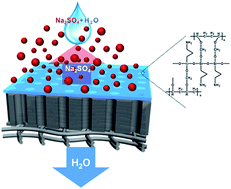Novel organic–inorganic hybrid composite membranes for nanofiltration of acid and alkaline media
Abstract
This study focuses on the development of novel organic–inorganic hybrid composite nanofiltration membranes based on poly(vinyl alcohol)-aminopropyl triethoxysilane (PVA-APES), which exhibit a rejection of 98.5% and a water flux of 13.5 L m−2 h−1 for a feed containing 2000 ppm Na2SO4 at 2.0 MPa at best-optimized aminopropyl triethoxysilane ratio and thermal cross-linking time. No irreversible changes in membrane performance have been observed after prolonged exposure (up to several weeks) of PVA-APES-1.0 membrane to the solutions with a pH in the range of 0–14. Moreover, after exposure to different acid solutions for 150 days, the Na2SO4 rejection of the composite membrane could still be maintained above 98%, and with an appropriate water flux. Notably, non-toxic solvent is used during the membrane preparation, showing enough green chemistry technology for environmental protection. A combination of high salt rejection, appropriate water flux, improved acid/alkali stability and environmentally friendly producing route indicates that these PVA-APES-xx membranes may be good candidate materials for nanofiltration in treating industrial wastewater at extreme pH values.


 Please wait while we load your content...
Please wait while we load your content...